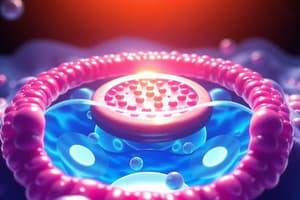Podcast
Questions and Answers
What are the main components of a cell membrane and their roles?
What are the main components of a cell membrane and their roles?
The main components of a cell membrane are phospholipids, proteins, and cholesterol. Phospholipids form the bilayer, proteins facilitate transport and communication, while cholesterol helps regulate membrane fluidity.
Describe the process of simple diffusion and give an example of molecules that utilize this process.
Describe the process of simple diffusion and give an example of molecules that utilize this process.
Simple diffusion is the movement of molecules from an area of high concentration to one of low concentration without energy input. Examples include oxygen and carbon dioxide.
How do integral and peripheral proteins differ in their association with the cell membrane?
How do integral and peripheral proteins differ in their association with the cell membrane?
Integral proteins span the entire membrane and are embedded within the bilayer, while peripheral proteins are associated with only one side of the membrane. This difference influences their functions in transport and signaling.
What role does cholesterol play in the structure of the cell membrane?
What role does cholesterol play in the structure of the cell membrane?
What distinguishes simple diffusion from active transport in terms of energy requirements?
What distinguishes simple diffusion from active transport in terms of energy requirements?
Flashcards are hidden until you start studying
Study Notes
Cell Membrane Structure
- Composed of a phospholipid bilayer - hydrophobic tails facing inwards and hydrophilic heads facing outwards
- Contains various proteins embedded within the bilayer:
- Integral proteins span the entire membrane
- Peripheral proteins are loosely associated with one side
- Cholesterol molecules are interspersed among the phospholipids, influencing the membrane's fluidity
Simple Diffusion
- Molecules move from an area of high concentration to an area of low concentration
- Does not require energy from the cell
- Examples of molecules that move by simple diffusion: oxygen and carbon dioxide
Other Transport Mechanisms
- Facilitated diffusion is not illustrated but is mentioned as another potential mechanism
- Active transport is not illustrated but another potential mechanism is mentioned
Studying That Suits You
Use AI to generate personalized quizzes and flashcards to suit your learning preferences.




